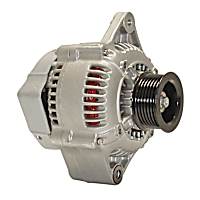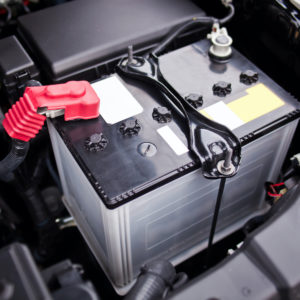If you want to know how to test a car battery with a multimeter, follow these steps:
- Set the device to read DC voltage
- Set the dial to 20 volts
- Connect the red lead to the red port, and the black lead to the black port
- Bring the black metal probe to the negative battery terminal post
- Bring the red metal probe to the positive battery terminal post
- Check the reading
Your results will vary. After testing a battery with a multimeter, a fully-functional battery should display a reading of 12.6 volts. Anything else, and you may have a bad battery on your hands.
What Does a Car Battery Do?
Your car’s battery is responsible for providing the jolt of electricity needed to start your car. The battery also supplies electrical energy to the rest of the vehicle whenever the engine is not running.
You can easily check your car battery’s state of charge using a multimeter. Although checking your car battery’s state of charge is not necessarily reflective of your battery’s overall condition, it’s a good place to start.
Note: No matter what kind of work you’re doing on or around the battery, always wear good eye protection such as safety glasses or a face shield. This is true even when jump-starting using jumper cables, because batteries can explode, and if you’re nearby when it happens you can sustain serious eye injury.
How Do Car Batteries Work?
A standard car battery contains 6 cells lined up in a row inside the plastic casing, and each cell contains a lead dioxide plate and a lead plate. These plates create 2 volts, resulting in a total of 12 volts for the entire battery.
With the cells submerged in sulfuric acid, a chemical reaction occurs that eventually generates the electricity that powers your vehicle’s starter motor.
The starter motor then converts this electrical energy into mechanical energy that starts the engine. With the engine running, the alternator now produces an electrical current that recharges your car battery.
What Is Amperage?
Amperage, or amps for short, is the rating of your car battery’s current. Car batteries typically have an amperage that ranges from 450 to 750 CCA.
What Is CCA?
Cold cranking amps, or CCA for short, measure the number of amps an auto battery with 12 voltage can deliver at 0ºF for 30 seconds while maintaining a voltage of 7.2 volts or more. A car battery with a higher CCA also has greater starting power.
Testing Your Car Battery’s State Of Charge With a Multimeter
A good car battery should be able to accept and hold a charge. If you want to check your battery’s overall health, you may ask a professional to do a load test using a hand-held digital analyzer. However, if you simply want to check the state of charge, you can do so with a multimeter. Be aware, though, that using only a multimeter can be misleading.

To put it simply, a multimeter refers to a device used to measure voltage, amperage, continuity, and resistance in electrical components and circuits.
If you’re the type who loves to DIY, then you probably own one.
A digital multimeter comes with two electric connectors with metal probes—the red wire stands for positive and the black one represents negative.
Before researching how to test a car battery, it is important to familiarize yourself with the device. If you’re used to doing a DIY car test, then you may proceed with doing the following steps on how to test a car battery with a multimeter.
How to Remove Surface Charge
If you’re going to test your car battery with a multimeter, make sure to remove the surface charge to avoid an inaccurate voltage reading.
Surface charge refers to a higher-than-normal charge that is just on the surface of the battery plates. If the battery has just been charged or if the car has just been driven, it will most likely have a surface charge.
Since a surface charge is quickly removed once a car battery is loaded, not removing it before testing may cause inaccurate results.
- Turn the high-beam headlights on for one minute.
- Turn the headlights off and wait for two minutes.
- Make sure that your engine is off. All electrical accessories must also be turned off. Keep the door shut to make sure that the interior lights are turned off.
Once you’re done removing your car battery’s surface charge, you may proceed with connecting the voltmeter or multimeter.
How to Check Your Car Battery with a Multimeter
Some of you might have thought about the following question at one point or another: “what voltage should a car battery be at?”. The answer is 12.6 volts, but if you want to check the voltage of your own car battery, you will need to learn how to use a multimeter.
This handy device can help you if you want to check the car battery’s state of charge, letting you know if your battery is normal, or if something has gone wrong. To check your battery, follow these steps:

- Set the device to read DC (direct current) voltage.
- After doing this, set the dial to 20 volts so you will be able to measure 0-20 volts. A fully charged battery should give out at least 12.6 volts, so setting the dial to 20 volts is enough. If you’re using an auto-ranging meter, you will not need to perform this step.
- It’s time to connect the leads. The red lead is positive and connects to a port that is generally red, while the black negative lead is connected to the black port on the meter labelled “common” or “COM” on the meter.
- Get the black metal probe (negative) and then hold or touch the tip to the negative battery terminal post.
- The red metal probe (positive) should also be touching the tip of the positive battery terminal post.
- As a guide, the terminals are marked “+” or “-.” After connecting the probe, make sure that you are not getting a reading of -12.6 or any reading with a “-” symbol in front. That would indicate a negative voltage and it means that the wires are wrongly connected.
Note: The resting voltage should not be lower than 12.6 volts. Take note that if a battery goes below 12.2V, it means it is 50% charged. If it goes below 11.9V, it is considered “discharged”.
- If you find that the meter reading is showing less than the ideal charge but the engine will start, you can watch the battery voltage while the engine is starting to see if it remains above 9.6 volts. After the engine starts, the voltage should move up to about 14.5 volts if the alternator is charging as it should.
- If you decide to trickle charge the battery, leave the battery to rest overnight and go back to test it again the following morning without connecting it to your vehicle. A battery that loses its charge when disconnected from the vehicle overnight is always bad. If it loses its charge while connected to the vehicle but not when it’s disconnected, the vehicle may have a parasitic drain.
- If the battery continues to lose its charge, you should have it tested by a professional. Professionals can determine the health of a battery using advanced equipment.
How Many Volts Should a Fully Charged Battery Have?
What should car battery voltage be? Fully charged automotive batteries should have a voltage of approximately 12.6 volts with the engine off and 14.5 volts with the engine running if the alternator is working properly.
Meanwhile, a battery voltage of less than 12.45 volts (less than 75 percent) is considered low. In this case, you may want to charge it until it reaches the normal car battery voltage. You may do this by driving your car around for 15 to 20 minutes at a speed of 40 mph or faster, or by connecting a portable charger to your battery.
For optimum performance, you need to keep automotive lead-acid batteries at least 75 percent charged. If you allow the battery to run down and you do not bring it up to 75 percent or more after a few days, you may permanently damage it.
How To Test a Car Battery Without a Multimeter
It’s better to use a multimeter to test your car battery, but in case you don’t have one, there’s a way you can still test your car battery. To do so, you’ll need to ask a friend to help you.
First, turn your headlights on, and then turn off your vehicle. With your friend in the driver’s seat, you can ask them to start the car. If your headlights dim as the engine starts, then your battery probably needs charging.
Other Ways of Testing a Car Battery
Another test you can do if the battery has removable caps is to use a hydrometer (they’re relatively inexpensive) to measure specific gravity from cell to cell. The specific gravity should be 1.260, meaning the battery fluid should weigh 1.26 times as much as pure water. Any cell that reads significantly lower indicates a problem.
A professional technician will typically use a conductance tester that measures battery cold cranking amps (CCA) as compared to the battery’s CCA rating. He or she will enter the CCA rating after connecting the tester, conduct the test, and the reading will provide the battery’s remaining cold cranking amps capacity.
A battery is sort of like an electric fuel tank, but it’s different than a liquid fuel tank because the older a battery gets, the less cold cranking amps it has. In other words, the battery’s CCA rating drops off with age until the battery is small enough in its capacity that it is no longer able to function. Conductance testers can be expensive, but there are affordable models available if you know where to get them.
Another way professionals like to check batteries electrically is by loading the battery to half its CCA rating for 15 seconds while watching to see if the battery voltage drops below 9.6 volts. This is a very intense test you won’t want to do at home and it requires test equipment that you won’t have at home.
Rather than using a piece of equipment to load their battery, some people will disable their ignition system and connect a voltmeter to the battery, then spin the engine for 15 seconds while watching to see if the battery voltage can sustain the 9.6 volt threshold during the entire 15 second spin. If it can maintain above 9.6 volts, it has sufficient capacity for that car.
The drawback to doing this kind of battery test is that you have to know how to do it right. Also, spinning the starter for 15 seconds if your starter is already weak may cause the starter to fail.
The Importance of Good Clean Battery Terminals

If you suspect you have a bad battery, you need to start with good clean battery terminals. Sometimes battery terminals will need to be replaced, and you may not have the skill or the tools to do it right.
Even if you have a good battery, nasty battery terminals will drop voltage and prevent the vehicle from starting – some vehicle systems won’t even operate the injectors if the battery voltage drops below about 7.5 volts while the engine is spinning.
What Causes a Car Battery to Drain?
There are several reasons why your battery can’t hold a charge. A parasitic drain may be caused by electrical problems such as a short circuit somewhere or an accessory (e.g., the headlights) that are being left on when the engine is off.
Leaving your headlights on, for example, may cause your battery to drain continuously overnight. To avoid this, make sure your automotive lights are turned off before leaving your vehicle for the night. Map lights, glove box lights, bad electronic components, etc. can also kill the battery.
Also, a faulty alternator could be the problem.
If you’re unsure of what is causing your battery to drain, it is best to have your mechanic do the necessary tests to accurately diagnose any car battery issues.
Symptoms of Low Car Battery Levels
Keep in mind that a low or dead battery does not automatically mean that it needs replacement. Several factors may affect your car battery’s state of charge, such as not driving your car for long periods of time or not driving it long enough.
You may want to check your vehicle’s alternator and the charging system for issues. Aside from a faulty battery, there may be something wrong with your vehicle’s electrical system, causing your battery to drain.
If you want to know how to check if your car battery is bad, keep an eye out for the following symptoms:
Slow Cranking
The most obvious sign of a low battery level is slow cranking when attempting to start your vehicle. In worse cases, there may be no cranking at all.
Malfunctioning Car Accessories
If your power window malfunctions or if your heated seats or electronic defrosters are not functioning as they should be, it may also be a sign of a low car battery.
Trouble Opening Car Doors and Trunk
With a low battery level, you may also have problems opening your car door and trunk if your vehicle is equipped with remote keyless entry.
When Should You Replace a Car Battery?
Though you can always recharge a battery that’s low on power, there will be times when you’ll be forced to replace a car battery entirely. Typically, this occurs if the battery gets damaged or corroded to the point that it can’t power the vehicle properly. It’s important to familiarize yourself with the signs it’s time to replace a car battery as opposed to merely recharging it.
Swollen Battery Case
One of the biggest signs it’s time to replace your car battery is if the battery case is swollen. This means the battery is overcharged, damaged, or simply too old. Swollen cases indicate too much gas inside the battery, turning them into safety hazards that are at risk of catching fire. In more extreme cases, these batteries can explode.
Old Age
Typically, car batteries need to be replaced every three to five years — though this depends on the quality of your car battery, driving habits, and the climate of your area. Though being older doesn’t necessarily mean its performance will be worse, using a battery too much can wear out the components. It’s a good idea to test your battery to see if it can hold charges properly. A battery can only be recharged so many times before its life depletes completely.
Battery Fluid Leaks
Battery fluid is a mixture of sulfuric acid and distilled water. It’s what allows the battery to create electricity. Because of this, if your car battery leaks this fluid, you’ll need to replace it as soon as possible. Leaks are typically brought about by damaged components within the battery, which are problems that can’t be fixed by merely recharging it.
Getting a Replacement Car Battery for Your Vehicle
Don’t let a bad car battery compromise your daily drive. If you notice that it drains quickly or exhibits signs that it needs a replacement, don’t delay addressing it. Here at CarParts.com, we like to make your repairs as convenient as possible, which is why we make it a breeze to find and order the perfect battery replacement for your ride.
After entering your car’s specifications into our vehicle selector to view direct-fit batteries, use the search filters to check out the ones that match your preferences. Place your order, and check out securely in minutes.
The best part? You won’t have to break the bank either because everything in our catalog is available at competitive prices. We also ship orders immediately from strategically located warehouses across the country. If you have questions, our friendly customer service team is available 24/7 through our toll-free hotline.
Check out our catalog and shop for a new car battery now!
Products Mentioned in this Guide
Any information provided on this Website is for informational purposes only and is not intended to replace consultation with a professional mechanic. The accuracy and timeliness of the information may change from the time of publication.



 Battery
Battery
 Alternator
Alternator






























